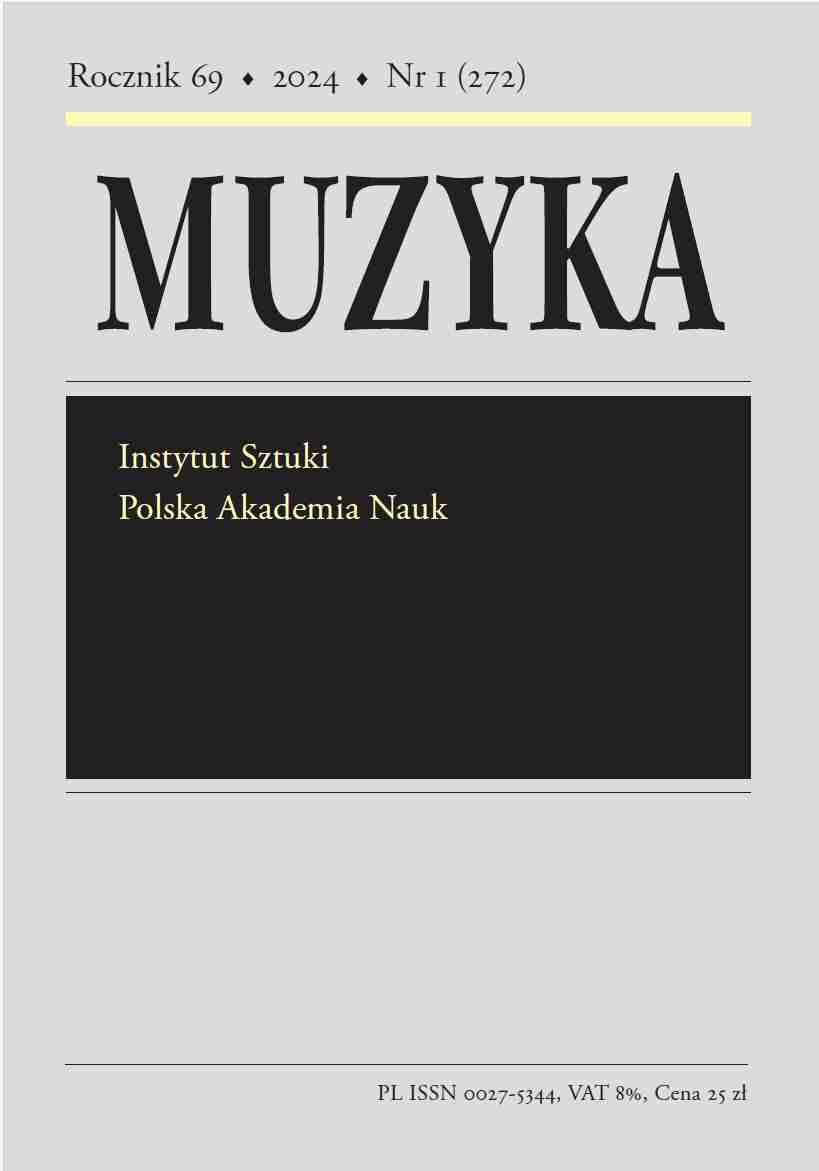Zastosowanie diagramatyki w obliczeniowej analizie muzycznej
Anna Maria Matuszewska
Instytut Badań Literackich, Polska Akademia Nauk (Polska)
https://orcid.org/0000-0002-3832-855X
Abstrakt
Repozytoria muzyczne zapisane w różnych formatach cyfrowych powstają z coraz większą dynamiką. Otwiera to szerokie możliwości badawcze, ale też wymaga od muzykologa nowych umiejętności pracy z dużymi zbiorami danych przy użyciu narzędzi cyfrowych, które ułatwiają przeszukiwanie obszernych korpusów muzycznych i coraz bardziej efektywnie służą analizie muzyki. Jakkolwiek zaproponowano już w tym zakresie wiele rozwiązań, wciąż istnieje potencjał lepszego zharmonizowania perspektyw badawczych muzykologii i informatyki, tak by wyniki analiz obliczeniowych były bardziej jednoznaczne, zrozumiałe oraz przedstawione w sposób umożliwiający ich dalsze przekształcanie. Konieczne jest również wyjście na przeciw potrzebom muzykologów i stworzenie interfejsów dedykowanych analizie muzycznej.
Celem niniejszego artykułu jest przedstawienie nowych sposobów przetwarzania, wyświetlania i rozpatrywania danych muzykologicznych. Wybrane informacje muzyczne z fug BWV 846-869 Jana Sebastiana Bacha, wygenerowane za pomocą programów Humdrum Tools, music21 i Music Processing Suite (MPS), zostały przetworzone w relacyjną bazę danych oraz zwizualizowane za pomocą tzw. dashboardów (zbiorów graficznych reprezentacji danych) z wykorzystaniem oprogramowania Tableau Public. Zastosowane w projekcie interaktywne rozwiązania zostały zaprojektowane tak, aby obliczeniową analizę uczynić możliwie intuicyjną i prostą do zaadaptowania. Proponowane dashboardy analityczne nie narzucają badaczom sztywnych reguł pracy, a możliwość rekonfiguracji przedstawionych danych i zawężenia zakresu analizy wybranego utworu do dowolnej kombinacji głosów, motywów czy taktów zapewnia możliwość eksploracji zarówno na poziomie ogólnym, jak i szczegółowym. Projekt został stworzony w oparciu o założenia rozumowania diagramatycznego zaproponowanego przez Charlesa Sandersa Peirce'a, a wielość dodatkowych opcji pozostawionych do decyzji użytkownika stwarza warunki do generowania hipotez abdukcyjnych.
Słowa kluczowe:
muzykologia obliczeniowa, interaktywna analiza muzyczna, diagramatykaBibliografia
Baroni, Mario, Simon Maguire, William Drabkin. „The Concept of Musical Grammar”. Music Analysis 2, nr 2 (1983): 175–208, https://doi.org/10.2307/854248.
DOI: https://doi.org/10.2307/854248
Google Scholar
Bauer, Matthias, Christoph Ernst. Diagrammatik. Einführung in ein kultur- und medienwissenschaftliches Forschungsfeld. Bielefeld: transcript Verlag, 2010.
DOI: https://doi.org/10.1515/9783839412978
Google Scholar
Blackwell, Alan Frank. „Metaphor in Diagrams”. Dysertacja doktorska, University of Cambridge, 1998.
Google Scholar
Borgman, Christine L. „The Digital Future is Now: A Call to Action for the Humanities”. Digital Humanities Quarterly 3, nr 4 (2009), http://www.digitalhumanities.org/dhq/vol/3/4/000077/000077.html, dostęp 21 XI 2021.
Google Scholar
Bruhn, Siglind. J.S. Bachs Wohltemperiertes Klavier Analyse und Gestaltung. Waldkirch: Edition Gorz, 2013.
Google Scholar
Buteau, Chantal, Christina Anagnostopoulou. „Can Computational Music Analysis Be Both Musical and Computational?”. Journal of Mathematics and Music 4, nr 3 (2010): 75–83.
DOI: https://doi.org/10.1080/17459737.2010.520455
Google Scholar
Cook, Nicholas. „Towards the Complete Musicologist”. W: 6th International Conference on Music Information Retrieval, London 2005, https://ismir2005.ismir.net/documents/Cook-CompleatMusicologist.pdf, dostęp 4 V 2023.
Google Scholar
Cuthbert, Michael Scott. „music21: a Toolkit for Computer-Aided Musicology”, https://web.mit.edu/music21/, dostęp 22 I 2021.
Google Scholar
Davis, William H. Peirce’s Epistemology. The Hague: Martinus Nijhoff, 1972.
DOI: https://doi.org/10.1007/978-94-010-2802-8
Google Scholar
Downie, J. Stephen. „Music Information Retrieval”. Annual Review of Information Science and Technology 37 (2003): 295–340.
DOI: https://doi.org/10.1002/aris.1440370108
Google Scholar
Dürr, Alfred. Johann Sebastian Bach. Das Wohltemperierte Klavier. Kassel: Bärenreiter-Werkeinführungen, 2008.
Google Scholar
Feisthauer, Laurent, Louis Bigo, Mathieu Giraud, Florence Levé. „Estimating Keys and Modulations in Musical Pieces”. W: Sound and Music Computing Conference (SMC 2020), red. Simone Spagnol, Andrea Valle. Torino 2020, https://hal.science/hal-02886399/file/2020-smc-modulations.pdf, dostęp 4 V 2023.
Google Scholar
Giardino, Valeria. „Behind the Diagrams: Cognitive Issues and Open Problems”. W: Thinking with Diagrams. The Semiotic Basis of Human Cognition, red. Sybille Krämer, Christina Ljungberg, 77–102. Berlin: De Gruyter Mouton, 2016.
DOI: https://doi.org/10.1515/9781501503757-004
Google Scholar
Heckmann, Harald. „Elektronische Datenverarbeitung in Musikdokumentation und Musikwissenschaft. Eine Einleitung”. W: Elektronische Datenverarbeitung in der Musikwissenschaft, red. Harald Heckmann, VII–XVII. Regensburg: Gustav Bosse Verlag, 1967.
Google Scholar
Hoffmann, David. „Music Processing Suite”. https://www.musicprocessing.net/, dostęp 21 I 2021.
Google Scholar
Hofmann, David M. „Music Processing Suite: A Software System for Context-based Symbolic Music Representation, Visualization, Transformation, Analysis and Generation”. Dysertacja doktorska, Hochschule für Musik Karlsruhe, 2018.
Google Scholar
Holtzman, Steven R. „A Program for Key Determination”. Journal of New Music Research 6 (1977): 29–56.
DOI: https://doi.org/10.1080/09298217708570231
Google Scholar
Huron, David. „The Humdrum Toolkit for Computational Music Analysis”. https://www.humdrum.org, dostęp 22 I 2021.
Google Scholar
Huron, David. „Humdrum Tools”. https://www.humdrum.org/tool/, dostęp 22 I 2021.
Google Scholar
Huron, David. The New Empiricism: Systematic Musicology in a Postmodern Age. Berkeley: Ernest Bloch Lecture, 2009.
Google Scholar
Inskip, Charles, Frans Wiering. „In Their Own Words: Using Text Analysis to Identify Musicologists’ Attitudes Towards Technology”. W: 16th International Society for Music Information Retrieval Conference, Malaga 2015, https://www.researchgate.net/publication/291096095, dostęp 4 V 2023.
Google Scholar
Jänicke, Stefan, Greta Franzini, Muhammad Faisal Cheema, Gerik Scheuermann. „On Close and Distant Reading in Digital Humanities: A Survey and Future Challenges”. W: Eurographics Conference on Visualization (EuroVis), 2015, https://www.researchgate.net/publication/282156818, dostęp 4 V 2023.
Google Scholar
Autorzy
Anna Maria MatuszewskaInstytut Badań Literackich, Polska Akademia Nauk Polska
https://orcid.org/0000-0002-3832-855X
Statystyki
Abstract views: 678PDF downloads: 399
Licencja
Prawa autorskie (c) 2023 Anna Maria Matuszewska

Utwór dostępny jest na licencji Creative Commons Uznanie autorstwa 4.0 Międzynarodowe.
Autor udziela wydawcy niewyłącznej i nieodpłatnej licencji (CC BY 4.0) na wykorzystanie tekstu w „Muzyce”, zachowuje nieograniczone prawa autorskie i zobowiązuje się do podawania miejsca pierwodruku w „Muzyce” przy ponownym wykorzystaniu artykułu (umowa licencyjna do pobrania). Zgłaszając artykuł do publikacji, autor wyraża zgodę na jego udostępnianie na licencji CC BY 4.0.
Artykuły w zeszytach od 2018/1 do 2022/3 publikowane były na licencji CC BY-NC-ND 4.0. W tym okresie autorzy/ki udzielali wydawcy niewyłącznej i nieodpłatnej licencji (CC BY-ND 4.0) na wykorzystanie tekstu w „Muzyce”, zachowywali nieograniczone prawa autorskie, ale zobowiązywali się do podawania miejsca pierwodruku przy ponownym wykorzystaniu artykułu.










